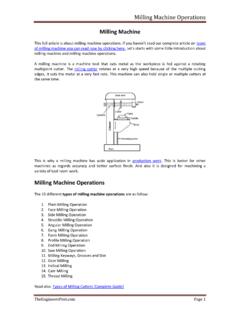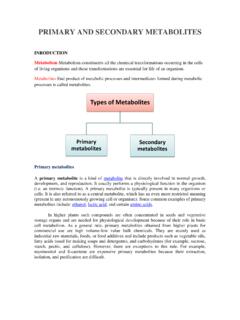Transcription of Modified Diet Definition of Modified Diet Concept
1 Modified diet Dietary modifications are changes made during food preparation, processing, and consumption to increase the bioavailability of micronutrients and reduce micronutrient deficiencies in food at the commercial or individual/household level (Beck and Heath 2013). Definition of Modified diet A Modified diet is any diet altered to include or exclude certain components, such as calories, fat, vitamins and minerals, according to Nutrition Essentials for Nursing Practice by Susan G. Dudek. Diets are typically Modified for therapeutic reasons, including treatment of high blood pressure, low body weight or vitamin and mineral deficiencies. Talk to your physician about diet modifications that may help your condition, and follow up with a nutritionist to help you make the best dietary choices Concept Dietary modifications are changes made during food preparation, processing, and consumption to increase the bioavailability of micronutrients and reduce micronutrient deficiencies in food at the commercial or individual/household level (Beck and Heath 2013).
2 Dietary Modifications diet : a diet that includes all foods and meets the nutrient needs of healthy people; also called a regular diet . diet : a diet that is altered by changing food consistency or nutrient content or by including or eliminating specific foods; also called a therapeutic diet . Examples of Modified Diets Type of diet Description of diet Appropriate Uses Example Modified Texture and Consistency Mechanically altered diets Contain foods that are Modified in texture. Pureed diets include only pureed foods; mechanical soft diets may include solid foods that are mashed, minced, ground, or soft. Pureed diets are used for people with swallowing difficulty, poor lip and tongue control, or oral hyper- sensitivity. Mechanical soft diets are appropriate for people with limited chewing ability or certain swallowing impairments Blenderized Liquid diet Contains fluids and foods that are blenderized to liquid diet liquid form.
3 For people who cannot chew, swallow easily, or tolerate solid foods. Clear Liquid diet Contains clear fluids or foods that are liquid at room preparation for temperature and leave minimal residue in the colon For bowel surgery or colonoscopy , for. acute GI disturbances (such as after GI surgeries), or as a transition diet after intravenous feeding. For short-term use only. Therapeutic Modification of the Normal diet 1. INTRODUCTION A therapeutic diet is a meal plan that controls the intake of certain foods. It s a practice followed in many hospitals as part of the treatment of a medical condition and are normally prescribed by a physician and planned by a dietician. A therapeutic diet is usually a modification of a regular diet . Diets are Modified for consistency, nutrition and new methods of making regular dishes.
4 The normal diet may be Modified : to provide a change in the constituents of the diet . to maintain, restore or correct nutritional status to include all nutrients in the diet to increase or decrease the energy value of the diet to provide foods bland in flavour. to modify the intervals of feeding. PRINCIPLES OF THERAPEUTIC diet A well planned diet providing all the specific nutrients to the body helps to achieve nutritional homeostasis in a normal, healthy individual. However, in disease conditions, the body tissues either do not receive proper nutrients in sufficient amounts or cannot utilize the available nutrients owing to faulty digestion, absorption or transportation of food elements, thus affecting the nutritional homeostasis of the sick person. The diet , therefore needs to be suitably Modified .
5 However, it is imperative that the basis for planning such Modified diets should be the normal diet therapy is concerned with the modification of normal diet to meet the requirements of the sick individual. The general objectives of diet therapy are 1. To maintain a good nutritional status. 2. To correct nutrient deficiencies which may have occurred due to the disease. 3. To afford rest to the whole body or to the specific organ affected by the disease. 4. To adjust the food intake to the body's ability to metabolize the nutrients during the disease. 5. To bring about changes in body weight whenever necessary. The advantages of using normal diet as the basis for therapeutic diets are 1. It emphasises the similarity of psychological and social needs of those who are well, even though there is quantitative and qualitative differences in requirements, thus ensuring better acceptability.
6 2. Food preparation is simplified when the Modified diet is based upon the family pattern and the number of items requiring special preparation is reduced to a minimum. 3. The calculated values for the basic plan are useful in finding out the effects of addition or omission of certain foods. ; if vegetables are restricted, vitamin A or Vitamin C deficiency can occur. Factors to consider in planning therapeutic diets 1. The underlying diseased condition which requires a change in the diet . 2. The possible duration of the disease. 3. The factors in the diet which must be altered to overcome these conditions. 4. The patients tolerance for food by mouth. In planning meals for a patient his economic status, his food preferences, his occupation and time of meals should also be considered. The four attributes of a therapeutic diet are; 1.
7 Adequacy 2. Accuracy 3. Economy 4. Palatability MODIFICATION IN CONSISTENCY These diets are used in the treatment of gastro intestinal tract. These diets can range from a very low residue diet to a very high fibre diet . Method of feeding is oral. a. DIETS WITHOUT SOLIDS (i) Liquid Diets Liquid diets consist of foods that are liquid at room temperature and are used in: Febrile states (acute fever) Post operative conditions b. DIETS WITH SOLIDS (i) Soft and Low Fibre Diets Soft diet is between liquid diet and normal diet . Soft diet includes both liquid and solid foods which contain restricted amount of indigestible carbohydrates and no tough connective tissue. The diet can be made soft by cooking, mashing, pureeing the foods used in a diet under normal conditions.
8 One could also use of refined breads, cereals, vegetables and fruits. This diet is soft in texture and bland to taste (ii) Low Residue Diets The diet is made up of foods which can be completely absorbed, leaving little or no residue for faeces formation. This diet is low in its mineral and vitamin content. Such diets need to be supplemented and foods high in fibre should be omitted. Two cups of milk may be permitted on a daily basis. Fruits and vegetables without skins are allowed. Meat should be tender or ground to reduce connective tissue. The diet is usually used in severe diarrhoea, acute diverticulitis, post operations etc. (iii) High Fibre Diets Dietary fibre plays a significant role in colonic function. A high-fiber diet includes foods that have a high fiber content.
9 Fiber is essentially the outer crust of fruits, vegetables, and grains that is not broken down by the body. It helps in excretion of body wastes. Its also well known that fiber regulates the cholesterol levels. Oats, beans, peas, and certain fruits and vegetables (oranges, pears, brussels sprouts, and carrots) are rich sources of fiber. Recommended in case of constipation, or high cholesterol. This is a normal diet with fibre increased to 15 20 gms daily. MODIFICATION IN NUTRIENTS Modification or change in the nutrient composition of the diet to increase or decrease the availability of nutrients to suit the body requirements / limitations of a person. a. High Calorie Diets This is a normal diet with an increase in the calorie level to 3000 or more. If appetite is poor, small servings of highly reinforced foods are given.
10 The diet may be Modified in consistency and flavour, according to specific needs. Excessive amounts of foods that have a low calorific value and fried foods which disturb the appetite should be avoided. These diets are prescribed for Weight loss Fever Hyperthyroidism Burns b. Low Calorie diet These diets controls calories, carbohydrates, proteins and fat intake in balanced amount to meet the nutritional needs and control blood sugar and weight. This is a normal diet with energy values reduced to 1500, 1200 or 1000 calories. Protein levels should be at 65 to 100 gms. Supplements of Vitamin A and thiamine are usually required for diets below 1000 calories. These diets are prescribed for reducing body weight in Diabetes Mellitus Cardiovascular diseases Hypertension Gout Gall bladder disease Preceding surgery.









